Ninja Weapons
The aikuchi is very similiar to the tanto except it has no hand
guard. The aikuchi could sometimes be thrown.
BLOWGUN
The blowgun was usually made from a bamboo piece usually about twenty
to forty inches long. In emergencies, a rolled up piece of paper
could be used as a temporary blowgun. The blowgun was favoured by the
ninja mainly because it was silent and the ninja did not have to reveal
his whereabouts´s to use it. Blowgun darts (fukiya) were made from
wires and paper. The paper was rolled in the 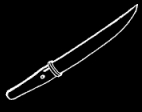 AIKUCHI
AIKUCHI
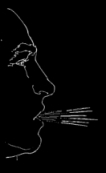 FUKIBARI
FUKIBARI
These
needles (about two inches long) were carried in the mouths of the
ninja. This dangerous needle was spit into the enemies face by
curling the tongue to form a tube shape. Other ways of spitting the
needles consisted of concealing a small piece bamboo in the mouth used to
shoot out as many as twelve needles at a time. Usually used as a
diversion before drawing the sword for a finish.
KAIKEN
 |
KAKUTE
 The Kakute or "horn finger"
is a metal ring that has two metal spikes attached. The kakute was
worn usually on the middle finger. This sometimes tipped with poison
weapon could be worn on either the inside or the outside of the
hand. The Kakute was favoured by the kunoichi (female ninja).
Deceiving enemies with this innocent looking weapon, then attacking at the
least expected moment.
The Kakute or "horn finger"
is a metal ring that has two metal spikes attached. The kakute was
worn usually on the middle finger. This sometimes tipped with poison
weapon could be worn on either the inside or the outside of the
hand. The Kakute was favoured by the kunoichi (female ninja).
Deceiving enemies with this innocent looking weapon, then attacking at the
least expected moment.
KAMA
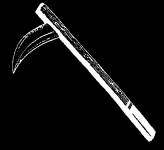 The kama or sickle was a
farming tool used to cut grass helping moving and reaping a farmers
crop. It was also used for other chores such as cutting wood and
digging. The kama of old was of light construction to the farmers
liking because they would spend hours farming. Later the kama was
developed into an effective martial tool, able to withstand heavy blows
from enemy attacks. Handles were often wrapped with a cord to give
them extra grip. The kama, like most weapons, is an extension of the
hand and can be performed more effectively with the knowledge of basic
taijutsu.
The kama or sickle was a
farming tool used to cut grass helping moving and reaping a farmers
crop. It was also used for other chores such as cutting wood and
digging. The kama of old was of light construction to the farmers
liking because they would spend hours farming. Later the kama was
developed into an effective martial tool, able to withstand heavy blows
from enemy attacks. Handles were often wrapped with a cord to give
them extra grip. The kama, like most weapons, is an extension of the
hand and can be performed more effectively with the knowledge of basic
taijutsu.
KATANA
KUNAI
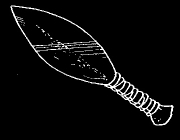 The kunai served several
purposes, primarily as a utility knife. The kunai tip was sharp with
very dull edges. It measured from seven to sixteen inches in
length. The kunai originated during the Tensho Era
(1573-1591). The kunai was often tied to the end of a rope fo
further its uses The kunai was used to help climb trees and walls,
and throw while tied to a small cord or knot. The kunai´s main
purpose was for probing, digging, and chiseling.
The kunai served several
purposes, primarily as a utility knife. The kunai tip was sharp with
very dull edges. It measured from seven to sixteen inches in
length. The kunai originated during the Tensho Era
(1573-1591). The kunai was often tied to the end of a rope fo
further its uses The kunai was used to help climb trees and walls,
and throw while tied to a small cord or knot. The kunai´s main
purpose was for probing, digging, and chiseling.
KUSARI-FUNDO / MANRIKIGUSARI
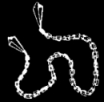 The ninja at times also
carried a long piece of chain usually two to three feet in length, with
two weights at each end. It was concealed from sight for the first
strike, it could be swung or thrown to entangle.
The ninja at times also
carried a long piece of chain usually two to three feet in length, with
two weights at each end. It was concealed from sight for the first
strike, it could be swung or thrown to entangle.
KUSARIGAMA
 This long
range blade and chain weapon is another favourite of the ninja. The
chain could be used to entangle and pull in the enemy to finish with the
blade. Some kusarigama had hand guards attached to the lower handle
for finger and hand protection. The kusarigama was a single edge
blade mounted to a wooden handle, a chain of nine to twelve feet was
affixed at the end. A iron weight was attached to the end of the
chain. On some kusarigama the chain is attached to the bottom end of
the handle while others it is attached to where the handle meets the
blade. The blade could be used to thrust, slash, chop, and
swing. The handle could deflect strike and block. The chain
could strangle, ensnare, whip, and aid in trap making. The weight
served as a frail or missile.
This long
range blade and chain weapon is another favourite of the ninja. The
chain could be used to entangle and pull in the enemy to finish with the
blade. Some kusarigama had hand guards attached to the lower handle
for finger and hand protection. The kusarigama was a single edge
blade mounted to a wooden handle, a chain of nine to twelve feet was
affixed at the end. A iron weight was attached to the end of the
chain. On some kusarigama the chain is attached to the bottom end of
the handle while others it is attached to where the handle meets the
blade. The blade could be used to thrust, slash, chop, and
swing. The handle could deflect strike and block. The chain
could strangle, ensnare, whip, and aid in trap making. The weight
served as a frail or missile.
KYOGETSU-SHOGE
NAGINATA
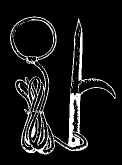 The one weapon that
resembled the kusarigama yet was made and used in an earlier time than the
kusarigama. It was made up of a hook knife with a long cord
approximately twelve feet that was attached to the end. At the end
of the cord was an iron ring about four inches in diameter. The
knife could be swung at or used as a finish after entangling with the
cord. The cord was used to ensnare, entangle, used like a garrote,
aid in trap making, and in the use of hojo-jutsu. The ring could be
swung into trees or over roof beams to aid in climbing, it could also be
used like the tekken in combat.
The one weapon that
resembled the kusarigama yet was made and used in an earlier time than the
kusarigama. It was made up of a hook knife with a long cord
approximately twelve feet that was attached to the end. At the end
of the cord was an iron ring about four inches in diameter. The
knife could be swung at or used as a finish after entangling with the
cord. The cord was used to ensnare, entangle, used like a garrote,
aid in trap making, and in the use of hojo-jutsu. The ring could be
swung into trees or over roof beams to aid in climbing, it could also be
used like the tekken in combat.
 |
NEKOTE
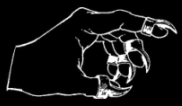 These small devices were
worn around the ends of the fingers. Their metal hooks could be used
to slash at the enemy. The tips were smeared with poison.
These small devices were
worn around the ends of the fingers. Their metal hooks could be used
to slash at the enemy. The tips were smeared with poison.
NINJA TO / SHINOBIGATANA
The ninja would carry metsubishi (blinding powder) at the bottom of his
scabbard to throw into the enemies eyes while drawing his sword. the
scabbard could also be used as a blowgun or snorkel. The scabbard
often served as a secondary weapon in time of need.
METSUBISHI
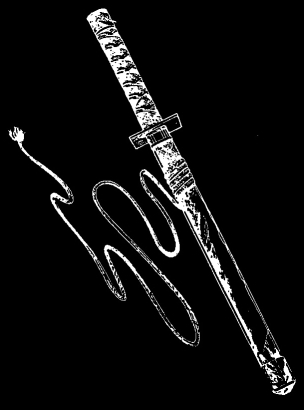 The sword carried by the
ninja was the ninja-to or sometimes called the shinobigatana. Like
most ninja weapons the ninja-to had a multitude of uses. The
Ninja-To was shorter than the katana, it could be worn across the back to
enable the ninja to climb without sword interference. The cord
(sageo) was attached to the scabbard (saya) about 12 feet in length.
The handguard (tsuba) unlike the katana, was square and larger. The
ninja-to could be laid against a wall to be used as a step to climb, the
sword could then be pulled up by the sageo.
The sword carried by the
ninja was the ninja-to or sometimes called the shinobigatana. Like
most ninja weapons the ninja-to had a multitude of uses. The
Ninja-To was shorter than the katana, it could be worn across the back to
enable the ninja to climb without sword interference. The cord
(sageo) was attached to the scabbard (saya) about 12 feet in length.
The handguard (tsuba) unlike the katana, was square and larger. The
ninja-to could be laid against a wall to be used as a step to climb, the
sword could then be pulled up by the sageo.
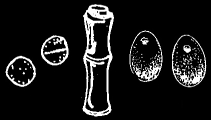 |
SHINOBI-ZUE
SHOBO
 The Shobo "short stick" was
concealed in the hand and used in close quarter combat. The shobo
could strike such areas as the bridge of the nose, groin, back of the
neck, or even to slap across the enemies face. The shobo usually had
a metal or leather loop attached to slip a finger through.
The Shobo "short stick" was
concealed in the hand and used in close quarter combat. The shobo
could strike such areas as the bridge of the nose, groin, back of the
neck, or even to slap across the enemies face. The shobo usually had
a metal or leather loop attached to slip a finger through.
SHURIKEN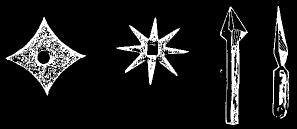 Ninja shuriken or shaken were hand released blades thrown at
the enemy for distraction purposes. Sometimes the blades were
poisoned to cause death. The shuriken was used to hit the enemy then
bounce away unseen. This gave an almost magical effect for the
ninja. The ninja shuriken was among the favourite tools of the ninja.
Though mostly thrown the shuriken could be used as a hand weapon for in
close combat. The shuriken would penetrate skin up to one half
inch. This behind the hand knife could easily be concealed about
the person or environment. The shuriken were carried in a
variety of ways all utilizing concealment and surprise. There are a
number of different types of shuriken, among the most popular are the
manji (swastika), hara (flat), sanpo (triangle), juji (cross), happo
(star), tatamijuji (folding cross), and the bo (straight). The
shuriken was thrown in thre basic ways, one from the front (omote), two
from the side (yoko), and the third from behind (ayaku). These three
ways did not limit the ninja´s capabilities in any way however.
Ninja shuriken or shaken were hand released blades thrown at
the enemy for distraction purposes. Sometimes the blades were
poisoned to cause death. The shuriken was used to hit the enemy then
bounce away unseen. This gave an almost magical effect for the
ninja. The ninja shuriken was among the favourite tools of the ninja.
Though mostly thrown the shuriken could be used as a hand weapon for in
close combat. The shuriken would penetrate skin up to one half
inch. This behind the hand knife could easily be concealed about
the person or environment. The shuriken were carried in a
variety of ways all utilizing concealment and surprise. There are a
number of different types of shuriken, among the most popular are the
manji (swastika), hara (flat), sanpo (triangle), juji (cross), happo
(star), tatamijuji (folding cross), and the bo (straight). The
shuriken was thrown in thre basic ways, one from the front (omote), two
from the side (yoko), and the third from behind (ayaku). These three
ways did not limit the ninja´s capabilities in any way however.
TANTO
 The tanto "half blade" of the ninja differed slightly ffrom the shinobi tanto. The shinobi
tanto would range in surprises, such as disguised pistols so the enemy
would watch the ninja draw his tanto yet actually he would be firing a
single shot. The shinobi tanto was sometimes equipped with a metal
saya (scabbard) which was used as a weapon itself. The tanto
was carried inside the ninja´s shinobi shozuko (uniform) held firmly by
his obi (belt) or sash.
The tanto "half blade" of the ninja differed slightly ffrom the shinobi tanto. The shinobi
tanto would range in surprises, such as disguised pistols so the enemy
would watch the ninja draw his tanto yet actually he would be firing a
single shot. The shinobi tanto was sometimes equipped with a metal
saya (scabbard) which was used as a weapon itself. The tanto
was carried inside the ninja´s shinobi shozuko (uniform) held firmly by
his obi (belt) or sash.
TEKAGI / SHUKO
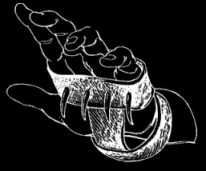 This item worn on the hands
was made of metal and tightened at the wrist. One kind was worn on
the palm of the hand and one on the back of the hand, four sharp spikes
protruded from this metal band. The claws could be used in close
quarter combat to tear like that of a ferocious tiger or bear. The
tekagi could also be used to aid in climbing walls and trees.
This item worn on the hands
was made of metal and tightened at the wrist. One kind was worn on
the palm of the hand and one on the back of the hand, four sharp spikes
protruded from this metal band. The claws could be used in close
quarter combat to tear like that of a ferocious tiger or bear. The
tekagi could also be used to aid in climbing walls and trees.
TEKKEN
 Similar to brass knuckles
the tekken was a curved piece of metal worn around the wrist like a
bracelet. When it came time to use, the tekken was slipped into the
hand to form a fist. This gave the ninja a bone breaking ability to
any strike.
Similar to brass knuckles
the tekken was a curved piece of metal worn around the wrist like a
bracelet. When it came time to use, the tekken was slipped into the
hand to form a fist. This gave the ninja a bone breaking ability to
any strike.
TESSEN
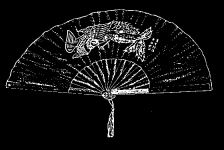 The tessen or iron fan was
a ninja weapon less famous than other weapons such as the shuriken.
The fan however was a very good weapon and tool. Closed, it could
make a harmful weapon as a small club, and opened it could deflect
projected missiles, the iron fan often had sharpened points. The
fan was good when the ninja was in disguise and couldn´t carry a sword or
staff. The kunoichi included a fan in their arsenal but that weapon
is termed sensu and was not made of iron like the tessen.
The tessen or iron fan was
a ninja weapon less famous than other weapons such as the shuriken.
The fan however was a very good weapon and tool. Closed, it could
make a harmful weapon as a small club, and opened it could deflect
projected missiles, the iron fan often had sharpened points. The
fan was good when the ninja was in disguise and couldn´t carry a sword or
staff. The kunoichi included a fan in their arsenal but that weapon
is termed sensu and was not made of iron like the tessen.
TETSUBISHI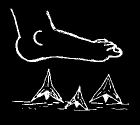 These spiked caltrops were excellent aides when it came to
evasion and escape. These were scattered on the ground for the enemy
to step on and slow or stop his pursuit. If the ninja had jumped
from a higher plane, he would sprinkle tetsubishi where he landed so that
enemy would have no choice but to fall on them if he followed.
Tetsubishi could also be placed on or along parts of walls and
trees. They could be thrown in the enemy face as a distraction or
tied to hidden traps. Tetsubishi were made of metal and from certain
natural resources. Due to the construction of the tetsubishi, when
thrown one point would always stick up. The tips of the Tetsubishi
were poisoned for a more serious effect.
These spiked caltrops were excellent aides when it came to
evasion and escape. These were scattered on the ground for the enemy
to step on and slow or stop his pursuit. If the ninja had jumped
from a higher plane, he would sprinkle tetsubishi where he landed so that
enemy would have no choice but to fall on them if he followed.
Tetsubishi could also be placed on or along parts of walls and
trees. They could be thrown in the enemy face as a distraction or
tied to hidden traps. Tetsubishi were made of metal and from certain
natural resources. Due to the construction of the tetsubishi, when
thrown one point would always stick up. The tips of the Tetsubishi
were poisoned for a more serious effect.
TORINAWA
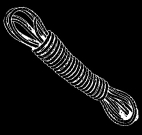 The torinawa is an
arresting rope used in hojo-jutsu rope techniques. The torinawa was
used to tie up enemies and to simulate a garrote. The torinawa could
be used for a hojo-jutsu techniques that caused the enemies to die if he
tried to escape from his binds by tightening a loop around his neck.
The torinawa was carried at an easy to reach place.
The torinawa is an
arresting rope used in hojo-jutsu rope techniques. The torinawa was
used to tie up enemies and to simulate a garrote. The torinawa could
be used for a hojo-jutsu techniques that caused the enemies to die if he
tried to escape from his binds by tightening a loop around his neck.
The torinawa was carried at an easy to reach place.
TSUBUTE
 Tsubute were flat metal
disks that were used by the ninja in a similiar fashion to the
shuriken. Thrown at an opponent these metal disks could stun or even
cause serious damage when hitting specific targets. Tsubute were
worn on a breakable cord on the neck to carry multiples at a time The
shaken were also sometimes carried in this manner.
Tsubute were flat metal
disks that were used by the ninja in a similiar fashion to the
shuriken. Thrown at an opponent these metal disks could stun or even
cause serious damage when hitting specific targets. Tsubute were
worn on a breakable cord on the neck to carry multiples at a time The
shaken were also sometimes carried in this manner.
WAKIZASHI
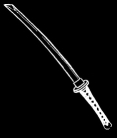 The
wakizashi was the samurai´s companion sword. Smaller than the katana
and the ninja-to. The wakizashi was a short with a quick draw and
easy manoeuvrability in small spaces such as hallways or small
rooms. The ninja liked the wakizashi because of its ease of carrying on a
mission, due to its size the ninja could stealth his way about without a
lot of trouble from his sword.
The
wakizashi was the samurai´s companion sword. Smaller than the katana
and the ninja-to. The wakizashi was a short with a quick draw and
easy manoeuvrability in small spaces such as hallways or small
rooms. The ninja liked the wakizashi because of its ease of carrying on a
mission, due to its size the ninja could stealth his way about without a
lot of trouble from his sword.
YARI